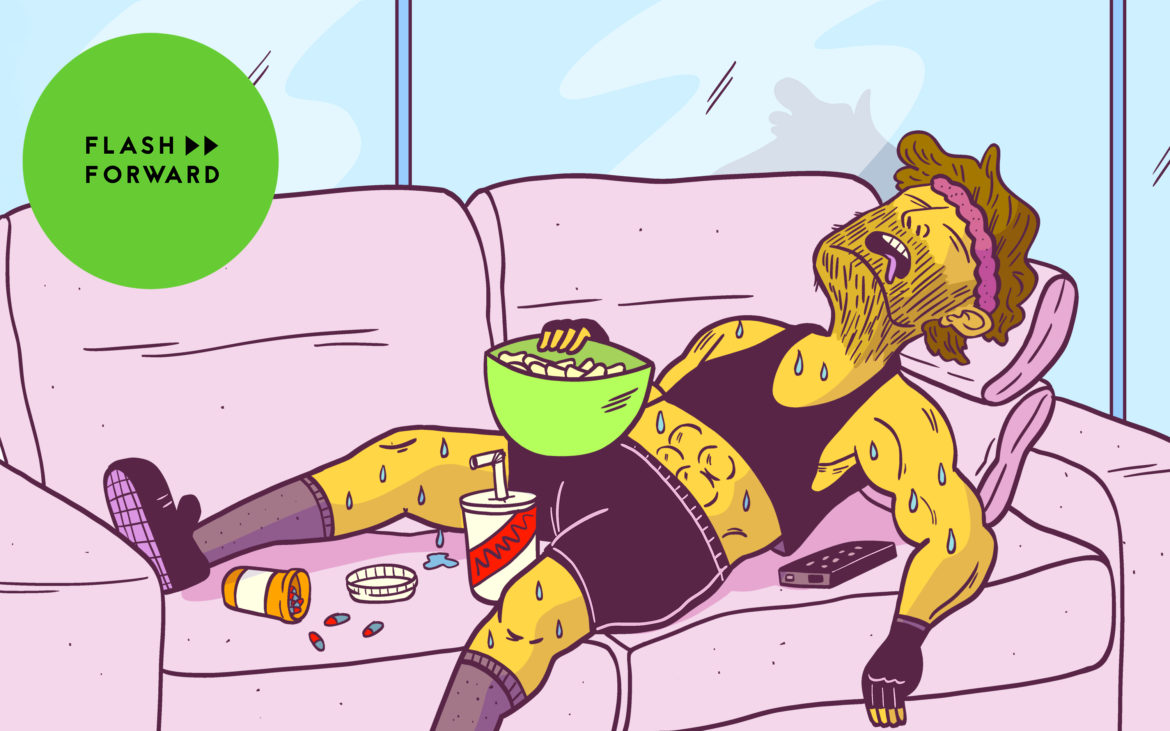- Nicola Twilley, co-host of Gastropod and New Yorker writer
- David Eveleth, my dad and biotech expert
- Natalia Mehlman Petrzela, historian and co-host of Past Present
- Sigmund Loland, philosopher of sports at Norwegian School of Sport Sciences
- Casey Johnston, editor at The Outline, author of Ask a Swole Woman
- Robert, my boyfriend
- Nicola Twilley, The New Yorker: “A Pill to Make Exercise Obsolete” (this is the article that inspired this episode)
- Exercise Pills: At the Starting Line
- “Caloric restriction and exercise “mimetics”: Ready for prime time?”
- “Exercise Mimetics: Impact on Health and Performance”
- “Exercise Mimetics: Running Without a Road Map”
- New peroxisome proliferator-activated receptor agonists: potential treatments for atherogenic dyslipidemia and non-alcoholic fatty liver disease
- Therapeutic modulators of peroxisome proliferator-activated receptors (PPAR): a patent review (2008–present)
- PPARδ: a dagger in the heart of the metabolic syndrome
- Ligand Earns $1 Million Milestone Payment as GlaxoSmithKline Advances Development of 501516; PPAR Modulator Offers Potential to Treat Dyslipidemias
- Sigmund Loland, “The exercise pill: should we replace exercise with pharmaceutical means?”
- Body Booster (this is the company that makes the machines Natalia was talking about.)
- What’s Wrong With Fat? by Abigail Saguy
- The big fat truth: More and more studies show that being overweight does not always shorten life — but some public-health researchers would rather not talk about them.
- Rachel Wiley, “The Fat Joke”
FULL TRANSCRIPT BELOW
▹▹ ▹▹ ▹▹ ▹▹ ▹▹ ▹▹ ▹▹ ▹▹ ▹▹ ▹▹ ▹▹ ▹▹ ▹▹ ▹▹ ▹▹ ▹▹ ▹▹ ▹▹ ▹▹ ▹▹ ▹▹ ▹▹ ▹▹
Hello and welcome to Flash Forward! I’m Rose and I’m your host. Flash Forward is a show about the future. Every episode we take on a specific possible… or not so possible future scenario. We always start with a little field trip to the future, to check out what’s going on, and then we teleport back to today to talk to experts about how that world we just heard might really go down. Got it? Great! Just a heads up on this episode we’re going to be talking about exercise and weight, which are difficult subjects for some people, so, proceed with that knowledge in hand!
Before we go to today’s future, I want to tell you about another podcast you might like. It’s called Sword and Laser. Here’s a taste.
[Sword and Laser Promo]
Okay, ready to go to the future? Let’s do it. This episode we’re starting in the year 2039.
[Cheesy music]
Infomercial Voice: Remember this?
[[old exercise clip]]
Or this?
[[clip]]
Or even this?
[[clip]]
Have you been searching for a way to boost your energy, shed some pounds and improve your health? Have you tried everything to stick to a workout regimen? Well, I’m here to let you know that there’s a better, faster and easier way.
I don’t know about you, but I simply don’t have time to gather all my things and go to the gym everyday. And home workouts, come on, we can be honest here, we both know they’re just too easy to skip. But you want that lean, toned body, am I right? Well, now you can have it, without fussing with a treadmill or lifting a single weight. You see it’s this, Hygieia. Hygieia is a revolutionary new formula that combines cutting edge modern science, and good old-fashioned flavor. Hygieia is easy, convenient, and tastes great! Simply add a few drops to your morning meal, and that’s it! You’ll watch as your endurance increases, and that stubborn fat melts away.
It’s no wonder that Hygiea is the leading exercise replacement formula. Try it today, call now for a special offer to get free shipping on your first order. Just call 1-800-HYG-IEIA, that’s 1-800-494-4342. Call today!
[music fades out]
Rose: Okay, so in this future there is a pill that can replace exercise.
Nicola Twilley: I mean I think everyone and like everyone every lazy person anyway. I have the fantasy of an exercise pill. It’s up there with winning the lottery in my life goals.
My name’s Nicola Twilley, and I am a writer and a podcaster. I co-host the podcast Gastropod, and I write for The New Yorker.
Rose: I talk about how much I like the podcast Gastropod all the time — it’s a great show! — but this time I’m talking to Nicky not about food, exactly, but about the future of exercise. Or, really, the future of NOT exercise. Because Nicky wrote a piece recently for the New Yorker about drugs that can replace exercise. And this might seem super futuristic, but it turns out there actually are drugs out there today that basically… do this.
Nicky: Five-One-Six was originally developed by GlaxoSmithKline
Rose: Technically the full name of this particular drug is GW-501516, but, for probably obvious reasons, nobody calls it that.
Nicky: The people who sort of talk about it online call it 516, for just the sheer effort of saying G W 5 0 1 5 1 6 is is too painful after a while.
Rose: So in the 1990’s, GlaxoSmithCline comes up with this drug.
Nicky: They thought it would be a treatment for something called metabolic syndrome. So that is that cluster of bad things – obesity, high blood pressure, high blood sugar – and it’s a precursor to even worse things like heart disease and diabetes. So, they were very excited about it. Nowadays, in its afterlife, it is now the leading contender for an exercise pill.
Rose: To see how effective 516 is, Nicky went to the Salk Institute in San Diego to meet two different mice, which she nicknamed Couch Potato Mouse, and Lance Armstrong Mouse.
Nicky: So Couch Potato Mouse is basically supposed to be an average American. It doesn’t exercise. It lives on what is basically cookie dough. It’s a lab diet that is supposed to mimic the Western diet. And Couch Potato Mouse was, when I met him, just kind of lolling around in his bedding. He was fat, visibly fat, rolls of fat underneath a sort of thinning, greasy fur. Even though I was there, there was no reaction, no twitching, no sort of moving away, nothing.
Rose: Then, there was Lance Armstrong Mouse. Lance Armstrong Mouse was also eating that same cookie dough diet, but he didn’t look anything like Couch Potato Mouse.
Nicky: Lance Armstrong Mouse was like super mouse. His coat was shiny. He was running around. His whiskers twitched. He was curious. Came over to sort of look at me, and twitch a little. He just, he looked great, basically. His fur was shiny. He was slim, sleek, strong looking.
Rose: So the two mice are in the same lab, in the same environment, eating the same food. And by now you’ve probably guessed the difference between them.
Nicky: The only difference between these two mice was that one was taking 516 every day and one wasn’t
Rose: Now, there are some problems with just looking at two mice and assuming that we can tell from how they look that one is healthy and one isn’t. Just like there are problems with looking at a human and assuming that we can tell who is healthy and who isn’t just by the way that they look. And we’re going to come back to the maye problematic assumptions about weight and exercise and health that might be going on in these studies. But first I should tell you one… uh… bigger problem with 516. You see, GlaxoSmithKline spent a ton of time and money developing 516 all the way through the early 2000’s. They did phase one clinical trials, and then phase two clinical trials, and then in 2007, they shelved the drug. At the time, nobody really knew why. But we do now.
Nicky: Then they got the results of their long term toxicity tests. So, what these toxicity tests were, were they basically gave mice really large doses of 516 over the course of two years which is a lifetime for a lab rat and these mice turned out to have developed cancer at a significantly higher rate than lab rats not given 516. You know, as tumors all over their bodies; tongue tumors, testicle tumors, everywhere.
Rose: So, yeah, tumors all over their bodies is bad. Bad enough that GlaxoSmithKline just dropped the whole project. There was no way they were going to get the FDA to approve a drug that might give people tumors all over their bodies.
But that wasn’t the end of the road for 516.
Nicky: They did publish the drug design and their results and that meant that other researchers could start playing with it.
Rose: And that’s exactly what researchers have done. So the mice that Nicky went to go see at the Salk Institute are part of a second generation of 516 experiments. The scientist behind Couch Potato Mouse and Lance Armstrong Mouse, a guy named Ron Evans, says that he’s developed a safer version of 516, with fewer side effects. And he’s trying to get that version of the drug approved for use in a really specific population.
Nicky: What he’s also done is pitched it as a treatment for Duchenne muscular dystrophy.
Rose: Duchenne muscular dystrophy is a form of muscular dystrophy caused by a mutation in the gene for a type of protein called dystrophin. That protein is crucial to keeping muscle cells intact. Without it, people’s muscles grow weaker and eventually can stop working all together.
Nicky: Here’s the thing, that’s a much easier sell to the FDA because there is no treatment for Duchenne. There is no cure. The kids are all going to die young. So the drug can have more serious side effects or more potential risks, I guess I should say, and still be approvable.
Rose: Now, 516 isn’t the only exercise drug out there. It’s part of a whole category of drugs that are called exercise mimetics. They mimic exercise in some way. They all work by different mechanisms and different pathways, trying to mimic different things that happen to the body when people work out.
Nicky: At the University of Southampton, there’s a drug called compound 14. This was discovered totally by chance by a researcher who was trying to disrupt cancer cell metabolism. And then found that this compound 14 actually just causes obese sedentary mice, who are busy eating again the cookie dough diet, it reduces their blood glucose levels to normal. It causes them to lose 5 percent of their body weight, etc. The way it works, is by tricking cells into thinking that they’re running out of energy, so they burn through more of the body’s fuel reserves.
Rose: There are a handful of people working on other versions of these drugs around the world, as well. But 516 is the furthest along.
Now, technically, 516 is not a drug you can buy, or even get prescribed, unless you’re part of a very small set of clinical trials for Duchenne muscular dystrophy. But the drug’s formula is public information, which means that anybody with the right equipment and supplies can make it. So along with folks in that clinical trial, there is another set of people who are currently taking 516.
Nicky: The world of people who like to take performance enhancing drugs.
Rose: At least five competitive cyclists have already tested positive for 516, and the World Anti Doping Agency actually issued a warning about the dangers of taking 516, writing “The side effect of this chemical compound is so serious that WADA is taking the rare step of warning ‘cheats’ to ensure that there is complete awareness of the possible health risks to athletes who succumb to the temptation of using GW-501516 for performance enhancement.” But it’s not just professional athletes who are taking 516. If you go onto bodybuilding forums, you can find tons of people talking about their 516 routines.
Nicky: Their avatars are all these headless bodybuilder shots, just ripped abs, and then they have these ridiculous names like “no fat chicks” and “big beef” and so on. And they’re all guys, and it’s a ridiculous misogynist place. And when I asked if the New Yorker fact checker could speak with Iron Julius he was like, “well send me photos first,” and I was like, “you are disgusting.”
Rose: So this Iron Julius Nicky is talking about is a guy on one of these forums that she interviewed for her New Yorker piece. Unsurprisingly, Iron Julius did not want to give his real name.
Nicky: He’s a firefighter based in the south. Takes steroids, is a bodybuilder, but not sort of cardiovascularly fit, originally. So he he said at the time when he first took 516, he couldn’t run a mile without running out of breath. And his wife had been bugging him to run a 5K with her; she was trying to get in shape and was doing a park-run type 5K. And he didn’t want to do it and he didn’t think he could do it. And he said, “well I’ll do it but I’ll walk.” And then he started taking 516. And he said it blew him away, how easy the 5K was. And admittedly 5K is not an ironman or something. But if you’re not training at all, and you can’t run a mile without getting out of breath and stopping, then being able to run 5K easily and happily without any training is actually pretty amazing.
Rose: It is pretty amazing, if it’s true! And it’s actually pretty in line with a lot of the stuff that I found on YouTube, people talking about how amazing 516 was for them. Now, you can’t necessarily trust these videos of course. A lot of people who make videos like these are also selling the products that they’re reviewing. Which doesn’t exactly make them trustworthy accounts. And even if they’re not selling the drug, they could simply be experiencing the placebo effect.
So, to test whether 516 actually works, Nicky decided to order some for herself.
Nicky: I’m just going to look up what my specific receipt said. There are a few different kind of names for it on the market. … Oh yeah, here we go… It was $97.99, very reasonable. And I ordered GW Aqua, is what they called it. Don’t ask me. I think that’s because it comes in liquid form.
And that’s what Iron Julius was like, “it’s best to take it that way as a liquid.” So I followed followed Iron Julius’s instructions. What’s really ridiculous about this is that it comes – this little dorpper bottle, looks like an eye dropper or something – there’s no dosage instructions. You or I is used to, when we get the drugs from the pharmacy; it says when to take it, and to take it with food or not with food, and how much, and how many times a day. Of course that stuff doesn’t exist for these kinds of drugs because you’re not supposed to be taking it anyways.
The other thing that I loved on the label, is it said “prescription only.” Then it underneath it it said “not for human consumption.” So, I was like, “awesome!” So what I did was I called the guy who originally designed the drug, basically. The GlaxoSmithKline scientist back in the 1990s; and I said, “look I have this. Would you take it if you were me? Would you take it if you were you?” Like I just asked and he was like, “No. Freaking. Way.”
And and so I had been all, “I’m going to do this. I’m a real reporter, blah blah blah.” And then I was like wait a minute. do I love the New Yorker enough to put poison in my body? I do not.
Rose: I, on the other hand, DO love this show enough to put poison in my body. At least, a little bit of poison for a short period of time. So, like Nicky, I ordered some 516 on the internet.
[audio of me unwrapping it]
Rose: Okay so it comes with a very handy dandy little dropper, like an eye dropper, water dropper type thing. And it’s in a blue bottle, like a little bottle, like a little shampoo bottle from a hotel. Solution facts: primary ingredient GW-501516. Handle with caution. Not for human consumption. For research purposes only. Oh, it expires on 1/2020. It also comes with a whole piece of paper that has a terms and conditions disclaimer. There’s a bunch of all caps later on, this is very long, the whole page is text, just keeps going. “All products and services offered are for RESEARCH purposes ONLY. Under no circumstances should or shall any of these matierials used for recreational purposes or human consumption.” Followed by three exclamation points. “All customers are assumed to be legal researchers or licensed researchers. If you or your affiliates are not, then we do not know this and you will be held liable for fraud-slash-deceit!!!” Three exclamation points. Uh oh, that sounds bad. And then, at the bottom, it says, “thank you for your business.”
So, the first question I had about this stuff, once I got it in the mail, was whether there was any way to figure out if the liquid in the bottle was actually 516 or not. So to figure that out, I called my dad.
David Eveleth: Hey Rose, how are you?
Rose: So, my dad used to work at the gigantic pharmaceutical company Pfizer, and he now runs his own biotech startup.
Rose: So, here’s my question: let’s say that I had some chemical in a liquid form. And I wanted to figure out what it actually was, how difficult is that to do?
David: The difficulty of the problem is really dominated by what you know about what it might be. If you start off with a “it could be anything,” that could be very difficult. If you start off with the assumption that is within certain boundaries, it can get a lot easier.
Rose: So, let me tell you what I think it is. So, I ordered this thing off the internet.
David: Yeah.
Rose: Have you heard about exercise memetic drugs?
David: Yes.
Rose: I’m doing an episode of Flash Forward about one of those. GW-501516.
David: Yes.
Rose: There are places you can get it, on the internet. And, they claim that that’s what it is. I think I know exactly what is in the bottle. But, my question is, because I did order this off the internet, who knows? Do I know that it is actually that? I don’t. So, if I gave this bottle to you, would it be hard for you to figure out if that is, in fact, what this chemical is.
David: It would not be hard. Given that that narrows the scope of what it should be to a fairly short list of potential molecules, figuring out if that’s what it is is very straightforward. Assuming that it’s a small molecule of a certain kind, I would feed it into an LCMS, and, you know, that’s a definitive identification.
Rose: Here’s the real question I have.
David: Yeah.
Rose: I have this thing that I ordered from the internet. And as part of the episode, I’m trying to decide if I should take it, or not.
David: Oh… and you want to do that cheaply and without a big chemical laboratory.
Rose: Preferably yes. I have a small budget.
David: Yes. Yes. Yeah. Absent, you know, a million dollars worth of scientific equipment and the knowledge to use it, unless there’s a kit that is around to identify that specific drug, then it’s going to be really difficult to determine if that is in fact what it is.
Rose: So, there’s really no way for me to figure out whether this bottle contains GW-501516 without a lot bigger budget for this show. But, the chances that this little bottle contains something WAY worse and way more potent is also pretty slim. It’s much more likely that it just contains ethyl alcohol and nothing else.
David: There are relatively few cases where people put something else in that is actually a potent drug. That’s just not their business model. There’s a couple of cases where people, selling Chinese herbal medicine and spiking it with sildenafil. Sildenafil because synthetic sildenafil, in China, is cheaper than the expensive actual herbal ingredients that they would otherwise have to put in this thing. And so, they were basically selling lawn clippings with sildenafil in it. by Agran Yes yes [00:09:03][40.0]
Rose: What is sildenafil? What is that?
David: Viagra
Rose: oh! Hehehe. Got it, got it, got it. I bet you it worked quite well, then.
David: Yeah, and their customers are happy, right?
Rose: Okay, so chances are, if it’s not 516 in the bottle, it’s probably just alcohol. If it is 516, well, then there’s the whole “cancers all over your body risk.” But that happened to mice when they took a lot of the drug over their entire lives. I have no plans to take this regularly. The amount that I have is small enough that I’m probably in the clear, as far as cancer goes.
Rose to David][: In your professional opinion slash dad opinion, should I take this thing I ordered on the internet?
David: Ah, you know, I’d be very cautious about that. Sorry. In my dad opinion, I would say, no. I would, yeah, I do know, I would say no. I’m sorry, i’ve seen too many adverse events to drugs that are supposedly safe and well tested.
Rose: If I’m honest, my real worry is that it works super well, and I’ll want to keep taking it.
David: Yeah, if it does, let me know and I’ll buy some.
Rose: Hehe, I will, I will.
Now, I want to be super, super clear about something: I am not in any way suggesting that any of you order this thing on the internet. This is not an endorsement of this drug, nor is it a suggestion that you should try it. Please don’t sue me.
Okay, with that out of the way, I’m still on the fence about whether I should try the 516 that I got or not. But before I decide, let’s talk about how we got to this precise moment in exercise history. And is taking this drug cheating in some way? Plus, does a pill that mimics the biology of exercise actually give you the non-muscle related benefits of exercise? All that and more, after this quick break.
[[AD]]
So, an exercise pill is coming whether we like it or not. And, in a lot of ways this pill is a really great encapsulation of a whole lot of historical and cultural factors that are colliding right now. So, to talk about how we got to this moment in time, I called up a historian:
Natalia Mehlman Petrzela: I’m Natalia Mehlman Petrzela, an associate professor of history at the New School in New York City, and I am working on a new book about post-war American fitness culture.
Rose: Natalia also co-hosts a podcast called Past Present in which historians, herself and two others, bringing historical insights to political and cultural debates.
When I first emailed Natalia about exercise pills, and being on this episode, she sent me a photo of herself using this… machine that she found in Paris.
Natalia: Oh my gosh, yes, only if you promise not to tweet that image. Ok, so backstory. As you know, I’m here in France for a semester teaching at Parsons Paris. And because I’m working on fitness culture, and because I love to work out, I’m kind of doing a very unscientific fitness tour of all sorts of different offerings here in Paris.
Rose: So on one particular day she found this incredible workout… thing.
Natalia: It’s called Body Booster. It’s built around some machines that are actually manufactured in Germany. And essentially the sell, as I was told by the woman who kind of pulled me in off the street and explained and very enthusiastic French, is in 20 minutes you get the same impact or effect as a three hour workout, that you don’t even move, you don’t sweat. And I have to try it.
Rose: When you look up Body Booster online they say, “You want to stay in shape, redraw your figure or relieve muscle pain, but you do not have time to exercise every week? This revolutionary system is so effective that one 20 minute workout per week is enough.”
Natalia: It involved wearing this kind of special outfit that they give you, which is this very thin black material, nothing underneath. And then strapping yourself into a contraption. Maybe I will let you share this, because you kind of have to see it to know what I’m talking about. But strapping yourself into this contraption where there are wires coming out of all of your muscle groups attached to a machine, and then the machine asks you to hold static positions while current is shot into your muscles. And the higher the current, the more powerful effect it’s supposed to have. And when I say static positions I don’t mean a plank, which actually is exercise of itself. I mean like weak lunge, arms out to the side. Nothing really like exercise.
Rose: You really do have to see a picture of this thing to really get what it looks like. I’ll post a link in the show notes to their page and some photos.
Natalia: That was sort of the closest I’ve ever experienced of a “you really don’t have to do anything and you could get the benefit of exercise.”
Rose: So the Body Booster claims that it works by something called electrical muscle stimulation, which is a way of delivering electrical impulses directly to your muscles to force them to contract.
Natalia: It felt like current shooting through your body, for lack of a better way to describe it. And I had mine up to, I’d say about, 70 percent intensity and she’s like, “I don’t want to hurt you too much the first time.”
I mean this is maybe a little TMI. But for all the mommies out there, the ones on your pecs felt like a very intense version of if you were nursing, when your milk comes in. And that’s how I described. The woman was so horrified when I said that, she was like 20 years old, and I tried to say it in French. She’s like, “uh, madam, madam.”
Rose: So this electrical muscle stimulation, is totally a real thing, it’s used in a variety of physical therapy settings when people have some kind of injury that prevents them from being able to use their muscles. Electrotherapy can help reduce atrophy by forcing a muscle that you can’t use to fire anyway. Athletes use electrotherapy, too, for both training and recovery. So technically, this machine, probably kind of works. At least a little bit.
Natalia: I mean, I was totally sore the next day. Kind of the way you would feel if you had exercised. But I have no desire to go back. It made me realize I love sweating. I love jumping around. I feel accomplished when I’ve run a couple miles or you know, done something. It felt a little bit like when you see those videos on youtube with those old reducing machines, the slenderizing salons from the 40’s, where those bands are kind of shaking women’s cellulite. It felt a little bit like that. It didn’t actually feel like that, but it felt like that kind of cultural product.
Rose: And it kind of is like those things. In fact, the message that you can get fit without breaking a sweat, or really exerting yourself isn’t new.
Natalia: Those 1940s machines in the slenderizing spas that would shake you; part of the reasoning for that was there were still very strong cultural notions and “scientifically” quote unquote, I should say scientistically, proven or believed notions that for women to engage in rigorous sweaty exercise was both a compromise to their fertility and their feminine appearance. And that was one of the reasons why all these women did this kind of ridiculous thing of standing still in their high heels and being shaken.
Rose: And there is still a little bit of stigma around women who sweat, who work hard. Women’s athletic clothing is still being engineered to value looks over function. Ask anyone who’s ever tried to shop for a reasonable sports bra. So we have that happening, and at the same time, we have this ever increasing obsession in the United States with efficiency.
Natalia: But what I do think is a kind of interesting analogue is the whole Soylent approach to eating. This idea of, “who really needs food anymore? We’ll just mix up this combination of nutrients and there you go.” You know. that certainly takes the Instagram-ability out of your beautiful kale creation, but it also fundamentally changes the nature of what food and eating is, right? It’s just an agglomeration of nutrients. It’s not about taste it’s not about sitting down with your friends, it’s not about anything but nutrients. And to me, that makes it a very strong parallel to this conversation that we’re having. Why do you do exercise? Well, it’s about the reaction of your fast and slow twitch muscle fibres, that’s it..
Rose: And then on top of that, we have Instagram, and the rise of what people call the “fitfluencer.” These are largely thin white women, who sell their workout plans and products on social media sites like Instagram and Facebook. And the dirty secret of a lot of these people is that the things that they are selling to their customers are not, in fact, the things that got them the bodies that they have. Most of them do very different workouts in their real lives than the ones that they are selling. And a lot of these women have also had plastic surgery and implants. So if an exercise pill existed, it might be another tool in their sort of secret arsenal.
Natalia: In this Instagramified world, where you both do the behind the scenes – and I do think it would remain behind the scenes, I don’t think anyone would be Instagram storying themselves popping these pills, right? Do you do this behind the scenes to enhance your looks and your performance and then show off like you did it the quote unquote natural way or real way? I mean, maybe that’s what it would come to.
Rose: So we have all of these things colliding right now. On the one hand, we’re constantly bombarded with the message that exercise is really important. We’re told that if we exercise we can have the kind of body that society claims indicates success: a skinny, mostly white, fit body. And if we have that kind of body, all the doors will be unlocked for us. We’ll be happier, more successful, more peaceful. But at the same time, most people are struggling to find the time and money and mental strength to regularly go to a gym where often their very physical existence is seen as less than and in need of fixing. Combine that with the cult of efficiency, where everywhere you turn there’s some article about how to wring productivity out of every single moment of every single day. And then add in all of the ways that big data, science and biometrics are heralded as answer to all of our problems.
You put all those things into your vitamix blender or whatever; mix them up, and this is what you get. An exercise pill.
Rose: So, you already kind of answered this, but my last questions for you is, would you take this drug, ever?
Natalia: I don’t think I would take it. No judgment to anybody who would. I just sort of fearful about putting things like that in my body. I say that as I’m drinking a Diet Pepsi now, which is known to be worse probably than anything. But, yeah, I probably wouldn’t take it, less because of my expertise as a kind of cultural critic of these things. and more because I’m sort of a nervous rule follower.
Rose: I like exercising, too! But I’m also way less careful than Natalia about what I put into my body. I have lots of tattoos, I have an RFID chip implanted into my hand. I’m not really one to avoid something like this just in general. So I decided to ask someone in my life who tends to be far more careful about this stuff than I am.
Rose: I’m asking you, as someone who cares about my health and well-being, whether you think I should take it.
Robert: Whether I think you should take it? Knowing you, I know that you have done quite a bit of research and read the studies about how this does replace working out. Now these studies, I’m assuming, also talk about the side effects of them, if at all, and the effectiveness level. I would want to know a lot more about the full picture of the drug, and its effect on humans before saying whether or not I think you should take it.
Rose: This is my boyfriend Robert.
Rose: OK, so no one knows the effect on humans because there haven’t really been human trials. We only know about mice. We know that in mice if you give them a whole lot of it for their whole lives they get tumors all over their bodies. But there are no long term health effects studies on humans.
Robert: I mean, in that case I would probably caution against it. I don’t think I would want to use it for myself. Obviously, it’s your choice and you can do whatever you want. And I pride myself on not being the kind of person going to tell you what to do.
Rose: That’s not true at all you’re telling me not to eat ramen like every week.
Robert: I don’t tell you you can’t eat ramen, I tell you you shouldn’t eat ramen. Which, I suppose, in the context of this conversation you probably should take this compound. If I’m going to recommend you don’t eat Top Ramen, freeze dried ramen, I will probably also recommend that you don’t take this untested compound that might give you tumors all over your body. I’m sure it will be fine if you do take it, and I’m a little curious as to the effects.
Rose: I thought you were going to be like, “what the hell is wrong with you? Don’t take it.”
Robert: No, I certainly understand the curiosity of it, and desire to take it. I mean, it’s probably not a good idea…
Rose: If I take it, and get a tumor, will you feel bad?
Robert: A little. Probably not as bad as you’ll probably feel.
Rose: So, my dad thinks it’s probably harmless, but that I shouldn’t do it. My boyfriend thinks that it’s probably harmless, but that I shouldn’t do it and also that I should stop eating freeze dried Top Ramen, which, for the record, I will never stop eating. But I have two last questions about this drug before I decide whether I want to try it out. The first is about ethics, and the second is about, I guess reality. Let’s start with ethics.
Is this pill ethical?
Sigmund Noland: All technologies have problematic sites and can be misused. So this is my concern, basically, when it comes to new bio-technologies, like this pill.
My name is Sigmund Noland. I’m a professor at Norwegian School of Sports Sciences.
Rose: Sigmund wrote a paper about the ethical quandary presented by exercise pills. Is it in some way unethical to reap the benefits of something without actually doing the thing? Or, to put the question another way, is there a danger in cutting out the exercising part of exercise? Are we actually removing something really valuable without realizing it?
Sigmund went about answering those questions by asking another: does exercise have instrumental value, intrinsic value, or both?
Instrumental value is when you do one thing so you can get another thing.
Sigmund: We do things for something else. We work to make money.
Rose: Intrinsic value means that doing the thing itself has value, regardless of the outcome. Lots of things have both instrumental and intrinsic value.
So what about exercise?
Sigmund: So when it comes to exercise and fitness, many people consider this an instrumental thing because it’s something you have to do. We call it a work out, or you need to exercise because this new summer is coming in. You need to fit in your swimming suit and your bikini and you have to look good on the beach. These are all instrumental justifications of exercise that I find very problematic. If this is the only value of exercise then the exercise pill is fine. And we don’t have to spend money and time and energy on exercise.
Rose: But if exercise also has intrinsic value, if it is valuable in and of itself, then Sigmund thinks that the pill raises some concerns. And he thinks that exercise does have intrinsic value.
Sigmund: The feeling of being alive, when your heart starts pumping. The feeling of being tired. The feeling of increasing your fitness. The feeling of reaching a steady state level, when you jog go you walk fast. When there is balance between your heartbeat and the need of oxygen of your body, this is a beautiful feeling of being alive. That is a value in itself.
Rose: Now, for some people, exercise is something they do because they want to achieve an aesthetic result, it is something that they do not enjoy. There are plenty of jokes and memes and posts online about how we should all suffer through the working out part to get the perfect beach body, or whatever. And so maybe, the exercise pill would be a good thing, a way relieve some of the stress and pain that people endure because they’re told they should look a certain way. But Sigmund says that isn’t treating the real problem there.
Sigmund: In such a culture, the problem is not really solved by an exercise pill, that’s just softening the symptoms. You have to go into that culture and take a critical discussion about the whole idea of fitness and exercise. You know, making people unhappy and under rigid body ideals that they cannot fulfill. That’s a misuse of exercise and that’s a reduction of its value.
Rose: In fact, Sigmund thinks that the people of the future will look back at our current relationship with movement and play and exercise and see it as basically the Dark Ages.
Sigmund: And I think a future historian will look back at our societies and shake their heads, and they will say, “why didn’t they solve the traffic problems? Why didn’t they solve the movement hostile urban environments we have today?” There will be a society where public transportation will be free and frequent. Where the pollution problem will be solved. Where every day movement will be natural and joyful. Funny stairs, nice music in the gateways, pavement colours, colors in the stairs of big buildings. People walk up and down with joy. This is a movement utopia. That’s one possibility actually. And i think that makes people happier. It’s a more humane and friendly society.
Rose: A movement utopia! That sounds quite nice actually.
So ethically, cutting out exercise is questionable because it cuts out something that has value, in and of itself. And that brings us to, I guess my biggest question about these pills, which is: what are we actually even replacing? Because… exercise contains multitudes. It’s not just one thing. It’s not purely a biological phenomena in which our muscles contract. This is why, for Natalia, putting on a suit and getting zapped to work out just didn’t really cut it. And that’s how Casey Johnston feels about it too.
Casey Johnston: I’m a process person, I think, is maybe how I would describe it. I’m not a results person. And I think that’s what attaches people to things like exercise, that you enjoy the doing of it and the day to day of it, rather than what you’re getting out of it.
My name is Casey Johnston, and I work as the future editor at The Outline and I write the column Ask a Swole Woman.
Rose: So, Ask a Swole Woman, if you’re not familiar with that lingo, is an advice column for women who want to get into lifting, or already are lifting. Specifically, Casey is a powerlifter.
Casey: My best ever squat is 246 pounds. That was a couple of weeks ago. My best ever bench is, I want to say, 135. My best ever deadlift is 275.
I would love to hit ]a 275 squat. A 150 bench would be ideal. And I’d love to break 300 pounds on a deadlift, like 305, I think is reasonable.
Rose: Powerlifting was not Casey’s first sport. Like lots of people, she turned to running first.
Casey: I wasn’t incredibly depressed in college. But I think I was depressed and Ididn’t feel like myself. And, you know, exercise being a big component of health, I was like, “I’ll try this.”
Rose: But eventually, running stopped giving her that thing she was looking for.
Casey: And after about six years, I got really sick of that and I felt like I wasn’t getting more out of it. But I was doing more and more and more of it.
I discovered lifting subreddits out there on the Internet, and saw people getting these really great results and feeling really strong and really good about themselves and eating a lot of food and living life to the fullest. And I was like, “wow, that’s what that’s what I want out of exercise.” I want to have to not think about food and not think about how I look. And just sort of do my exercise and eat my food and let it all take care of itself. And lifting felt like it did that so much more for me than running ever did.
Rose: Like a lot of people, Casey uses exercise as a way to turn off her brain a little bit.
Casey: Running gave me a lot of time to think, which was not really what I needed. I have more time to fret. Lifting, you have to have such total focus on what you’re doing that you don’t have room to think about other stuff. So I will go into the gym, and come out after an hour and be like, “wow, I really didn’t think about anything outside of the gym for that whole time.” And it’s so refreshing to have a break from your life that way,
It’s a very primal like thing. I compare it, in the best in the best possible way, to getting chased by a bear where you just can’t think about anything else. You have to focus on what you’re doing.
Rose: And that’s not something that you get when you take an exercise pill.
[to Casey]: What percent – and this is an impossible question to answer, I think you’ll understand what I’m driving at – what percent of the benefit of going to the gym do you feel like is from the actual physical lifting weights, and how much of it is from the whole process going and not having to think of all the other stuff
Casey: Hmmm, I definitely do get something out of the specific activity of lifting weights and feeling accomplished. And that’s another benefit of it, is that you do feel like you did. It’s so valuable to feel like you completed something, it’s a thing that you can complete. That it’s lifting weights doesn’t really… that can be true of rock climbing, that can be true of running. Let’s say, maybe 30 percent, 40 percent, the actual lifting of the weights. And then 60 to 70, just all of the things that happen around the lifting of the weights.
Rose: Even when I tell Casey the story of the mice, the Couch Potato Mouse and Lance Armstrong Mouse, the cookie dough diet, one looks so much better than the other; she’s not impressed.
Casey: The question that immediately comes up for me, from all of this, is how do the mice like feel?
Rose: And this is, in my opinion, the biggest critique of these exercise pills for general use. When we decide that exercise is only a certain specific bodily function; a certain series of reactions within our muscles and lungs and heart that we can replicate with a drug; that does a huge disservice to what moving the body actually means for a lot of people.
It’s no secret that the fitness industry has, for a very long time, pushed forward images of exercise and the body that are narrow and exclusive. Right now, particularly in places like the United States, there is an incredibly toxic idea that if your body doesn’t look a certain way you are immoral. People judge one another’s bodies all the time in ways that are both not scientifically sound, and also just plain mean and terrible. In fact, there are compelling arguments that the “obesity epidemic” is a cultural phenomenon, not a medical one. There’s a really thought provoking book called “What’s Wrong With Fat” by Abigail Saguy that really digs into the ways that culture has impacted how we talk about weight and bodies.
Now, there’s no question that this pill could be really useful for some people. But there’s also a layer of cultural critique that I think has to be leveled when we’re more willing to prescribe people pills than to expand our narrow definition of exercise to mean something more inclusive and expansive. Because there’s a dystopia to be had here, right? It’s not hard to imagine doctors prescribing this drug to people they deem overweight.
It’s well understood that many people don’t have the time, resources or invitation to move their bodies in a way that works for them, but to see the solution in medication rather than economic and social change is pretty dystopian, in my opinion.
So, after reading all the papers I could find, and talking to all these people, I’ve decided that I am going to try 516 that I goto n the internet. But because I don’t want this to be a wasted exercise, I need to design some kind of experiment to see if it’s actually working. My usual sport of choice, right now, is rock climbing, which isn’t a great sport to test this on. Every route is different, they each require a combination of flexibility, strength, footwork, balance and endurance. It’s why I like the sport, but it also makes it a pretty bad form of exercise to use for testing this drug.
Of course, there’s no way for me to design a truly good experiment here, considering I am just one human and there are a ton of variables at play. But I’m going to test it with as much control as I can. But to do that properly, though, I’m going to need a little bit more time. So I’m going to bring you the results of the 516 experiment in a future episode so… stay tuned.
[music up]
That’s all for this future … for now. For more information about exercise pills, and to hear more about our guests this week, head to Flash Forward Pod Dot Com. Flash Forward is produced by me, Rose Eveleth. The intro music is by Asura and the outtro music is by Hussalonia. The episode art is by Matt Lubchansky. The voice from our intro this week was played by Tamara Krinsky, check out her new show Tomorrow’s World Today, which premiers on the Science Channel at 8am on Saturday, May 5th. It’s a show after Flash Forward’s heart, all about technology, innovation and creativity. Special thanks to Nicola Twilley, whose New Yorker article started this whole thing. I’ll post a link to that story in the shownotes and online. You can listen to Natalia Mehlman Petrzela’s podcast Past Present on any podcasting app. And you can find Casey Johnston’s column and newsletter Ask a Swole Woman at SELF or at her website, caseyjohnston.net.
If you want to suggest a future we should take on, send us a note on Twitter, Facebook or by email at info@flashforwardpod.com. We love hearing your ideas! And if you think you’ve spotted one of the little references I’ve hidden in the episode, email us there too. If you’re right, I’ll send you something cool.
And if you want to support the show, there are a few ways you can do that too! Head to www.flashforwardpod.com/support for more about how to give. But if that’s not in the cards for you, you can head to iTunes and leave us a nice review or just tell your friends about us. Those things really do help.











6 comments
I just listened to this release and loved it. Keep up with the great stories and research.
[…] Sciences Casey Johnston, editor at The Outline, author of Ask a Swole WomanRobert, my boyfriend Further reading can be found here, including background documents, research papers, suggested books …“ At the link find the title, “Fitness in a Bottle, Apr, 2018,” right-click “Media files […]
[…] Read More […]
[…] If you missed the episode that spawned this experiment, listen here first: […]
I listened to this episode (I’m behind, getting caught back up!), and I want to make a counter-point.
I’m a software engineer – I work long, exhausting hours, and at the end of the day I don’t want to exercise, I just want to relax. Now, I really love my career – I get paid to show up and solve really interesting problems, and I enjoy my work deeply.
Now, I used to be in pretty great shape – I had a bicycle that I rode as my primary transportation all the time, and it felt good to be me. Over the years, my job has become more demanding and I do not have the time and bandwidth for an extra hour commuting every day, and I’m in much worse shape than I used to be, and it sucks. I ‘d *love* an exercise pill – something I could easily slot into my routine, a no-stress, no-effort fix that could make me feel as good as I did when I had a regular exercise routine.
Thanks for the show, always a fun listen.
[…] Podcast Pick: Flash ForwardEpisodes: Money for NothingFitness in a BottleUnreel […]